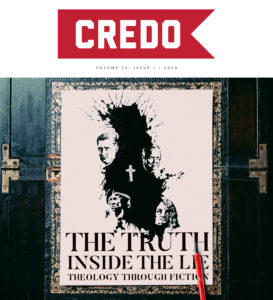In his very insightful book, Experiment in Criticism, C.S. Lewis advanced a novel approach to evaluating the quality of literature. Instead of putting the book in question under a microscope, and examining it with the eye of the trained critic, established criteria in hand, he suggested that we put the average reader of that book, or of that kind of book, across from us in a comfortable chair, and have a discussion with him about it.
This might not be an actual conversation, and be more of a thought experiment, but you still get the idea. The study of literature involves more than studying the intent of the author—it includes also studying the intent of the readers. And in this proposal of his, Lewis identifies two different kinds of readers, who in their turn help us identify the different kinds of writers. 
This approach led Lewis to suggest a book that a reader returns to again and again is a book that should be treated as an artifact which contains something valuable. The kind of “just-kill-the-time-on-an-airplane” book, the kind you find clogging up airport bookstores, is a consumption item—like a package of Ding Dongs purchased at a convenience store. You use it for its very temporary purpose, and then throw the delivery platform away. It is the kind of book you might find at a garage sale in a cardboard box, filled with similar books, and tagged at fifty cents for the lot.
Of course, we can’t be too strict with this airport illustration, in that Lewis himself purchased a book that was a genuine milestone in his life—MacDonald’s Phantastes—at a train station when he was a teenager. Just think how different twentieth century Christianity would have been if he had purchased Last of the Breed by Louis L’Amour instead.
Now judged by this most admirable criterion, That Hideous Strength constitutes a formidable presence in my life. I have read it somewhere around fifteen times, and so I might want to take Lewis’s standard up a notch. He argued a book was worthwhile if someone could return to it again and again, and each time find the return visit amply rewarded. This has certainly been true in my experience, but my relationship with That Hideous Strength actually goes well beyond that. My situation is such that I find that if I haven’t read it for a while, I must return to it. And I expect to feel this way about it until the river Jordan is up at least to my knees.
But why?
The Abolition of Man and That Hideous Strength
Owen Barfield once said that what Lewis thought about everything was contained within what he said about anything. This is simply a way of describing what integrated worldview thinking is like, and Lewis certainly provides us with a good example. But in the case of Lewis, the times he operates this way are far more evident than at other times. The publication of That Hideous Strength, and the company it keeps, points to one of those times.
To begin with, The Abolition of Man and That Hideous Strength really need to be treated as companion volumes. In his preface to THS, which Lewis wrote in 1943, he says, “This is a ‘tall story’ about devilry, though it has behind it a serious ‘point’ which I have tried to make in my Abolition of Man.”
The only thing to take issue with here is his use of the word tried. He didn’t try to make this serious point, he made it—fully, seriously, compellingly. And the need for us to understand that particular point has not diminished in any way in the decades since.
In his book, The Year of Our Lord 1943, Alan Jacobs has helpfully pointed out that this particular intersection of thought involved more than just these two works.
His key insight into this genealogy [of science and magic] may be found in the bravura introduction to the history of English poetry and prose in the sixteenth century, a book that he agreed to write in 1935 but did not complete until 1953. Along the way he condensed some of that project’s major themes into the 1944 Clark Lectures at Cambridge, and those themes overlap strongly with those of his novel That Hideous Strength, which he began at the end of 1942, just as he was writing the Riddell lectures [the basis for Abolition]. . . It is therefore helpful to explore The Abolition of Man in conjunction with these other texts that are so closely related to it.
Now as it happens, I have read The Abolition of Man almost as many times as I have read That Hideous Strength, and this cannot really be described as coincidental.
It is dangerous to point to a few objects of interest in texts that you are claiming would actually repay a lifetime of return visits, as though what you are pointing to might exhaust the treasure to be found there. So if you will permit me to wave off any such notion, I will then feel free to point to a small handful of things that I believe relate to the essential point.
In Abolition, Lewis points out how science and alchemy were born at the same time, and in the same neighborhood.
The serious magical endeavor and the serious scientific endeavor are twins: one was sickly and died, the other strong and throve. But they were twins.
It might be going too far to say that the modern scientific movement was tainted from its birth: but I think it would be true to say that it was born in an unhealthy neighbourhood and at an inauspicious hour.
In That Hideous Strength, we find these separated twins are reunited. The evil forces of the N.I.C.E. are supreme technocrats, using the machinery of bureaucratized science and technology to mow down anything that gets in their way, and it appears that what is getting in their way is anything distinctly human. Their whole enterprise is undertaken in the name of Science, all rise. But as they pursue the implications of their scientific revolution, they find that they are doing the bidding of “macrobes,” their pseudo-scientific name for what are actually powers of the air, which is to say, devils. They have come full circle. By declaring war on all that was truly spiritual in man, they invited in all that was truly “spiritual” in the ranks of fallen angels. The scientist has become the magician; the mad scientist has become the necromancer. By declaring war on all that was truly spiritual in man, they invited in all that was truly “spiritual” in the ranks of fallen angels. The scientist has become the magician; the mad scientist has become the necromancer. Click To Tweet
Surrender and Defiance
The story revolves around the separate tracks of Mark and Jane Studdock, recently married, and quite unhappily so. They both contribute significantly to their shared unhappiness, and each one does so by missing the point of two other essays that Lewis wrote around this same time.
Mark Studdock would have profited greatly by reading “The Inner Ring,” as that essay describes in great detail the devil that drives him. That Hideous Strength makes the same point that the essay does through a long and sustained narrative, with Mark being the walking embodiment of the lust described. Mark is tantalized, constantly, by the prospect and opportunity of being included in the “next” inner circle, and that ravenous lust to be included is the center of his life. “The Inner Ring” is included in The Weight of Glory, and was originally an oration presented at King’s College in 1944, the year after That Hideous Strength was published.
And Jane would have profited by reading “Membership,” also included in The Weight of Glory. In that address, Lewis examines what it really means to belong to one another, and what true organic relationships are actually supposed to be like. The true “belonging” that he describes there is Jane’s bête noire, as the French would say. An American would say that the very idea of belonging like that gave her the fantods.
Mark is driven by a desire to get in, whatever the cost, and Jane is consumed by her desire to stay out, at all costs. His desire to belong to the progressive element, or to the smart set, or to the next sparkling group that is really in the know, is a desire that has already cost him the genuinely valuable friendships that he used to have, and is an important part of the reason why his marriage to Jane is so strained.
For Jane’s part, she does not want to surrender herself, to give herself up. This reluctance is important to the plot of the book because her strong desire not to give herself to motherhood “just yet” is the reason why the birth of a great deliverer for Britain had been prevented. And because, as Ransom notes, submission is an “erotic necessity,” her unwillingness to surrender herself completely is another contributor to the tensions in her marriage to Mark. And though she wants to be with the “nice” people at St. Anne’s, she is very reluctant to join them as a member of their company. She is most reluctant to be “taken in.” She wants to be with them, but would much prefer to be with them on her own terms.
And so because both Mark and Jane must be converted in the course of the story, this means they must repent of their respective sins—and these acts of repentance have to move in opposite directions. Mark must repent of his craven desire to be included, and this is why his repentance is marked by his act of rebellion. And Jane must repent of her desire to hang onto her own identity, and so her conversion is a striking act of submission, a surrender of that rebellion.
As part of his training in “objectivity,” Mark is being required by Frost to trample on the face of a crucifix. And when he finally comes to his breaking point, he says, “It’s all bloody nonsense, and I’m damned if I do any such thing.” As for Jane, she is walking outside the manor at St. Anne’s. “Then, at one particular corner of the gooseberry patch, the change came.”
In this height and depth and breadth the little idea of herself which she had hitherto called me dropped down and vanished, unfluttering, into bottomless distance, like a bird in a space without air.
All must come to Christ, but because he is at the center, it means that some come from opposite directions.
Wither, Frost and Studdock
The central point of Abolition had to do with the demolition job that a certain pernicious form of education accomplishes when consistently applied. When this form of education is set loose among the children of men, the end result is the eradication of men. Lewis is pointing to the difference between being educated and being erased. Nothing is more obvious at the end of the process and so hard to see at the beginning of it.
One section of Abolition is entitled “Men Without Chests.” Man has an animal body, of course, and man also has reason. But, as Lewis points out, he also has sentiments of practical reason—the heart, the chest, the trunk. And Mark is an almost perfect example of the kind of end product that modern schools were turning out, the kind that Lewis was objecting to so strenuously in Abolition.
It must be remembered that in Mark’s mind hardly one rag of noble thought, either Christian or Pagan, had a secure lodging. His education had been neither scientific nor classical—merely ‘Modern.’ The severities both of abstraction and of high human tradition had passed him by: and he had neither peasant shrewdness nor aristocratic honor to help him. He was a man of straw, a glib examinee in subjects that require no exact knowledge . . . and the first hint of a real threat to his bodily life knocked him sprawling.
Set this description of Mark alongside that famous passage from Abolition:
In a sort of ghastly simplicity we remove the organ and demand the function. We make men without chests and expect of them virtue and enterprise. We laugh at honour and are shocked to find traitors in our midst. We castrate and bid the geldings be fruitful.
Mark Studdock was still in the process of his degradation, but Wither and Frost were both examples of men already long gone. They had already graduated into their eradication as men.
And Lewis had them well in hand, admirer of Bunyan as he was, when he gave them their names. When Wither realizes that all was lost, it was incredible “how little this knowledge moved him.” “It could not, because he had long ceased to believe in knowledge itself.” And here, as Wither stood on the lip of “endless terror,” it is striking that Lewis points back to the curriculum he had worked through. From Hegel to Hume to Pragmatism to Logical Positivism to . . . the “complete void.”
Frost descended into epistemic madness by a different route, but it was not all that different. “The nearest thing to a human passion which still existed in him was a sort of cold fury against all who believed in the mind . . . He became able to know (and simultaneously refused the knowledge) that he had been wrong from the beginning, that souls and personal responsibility existed. He half saw: he wholly hated.”
And of course, in this book the focal point for all these machinations of the bad guys was the Head—a severed and detached head hooked up to tubes and dials, and with absolutely no chest at all.
The Company at St. Anne’s
One of the great takeaway lessons of this book, for me at any rate, and related to all the foregoing, is the greatness of insignificant service. One of the great takeaway lessons of this book, for me at any rate, and related to all the foregoing, is the greatness of insignificant service. Click To Tweet
When Fairy Hardcastle faces the problem of finding out who Mark Studdock may have seen in his unauthorized visit to town, she has three men she needed to tail and only two men that she could assign to do the job. Those three men are Lancaster, Lyly, and Dimble, and she decided to go after the first two. “Both these are dangerous men. They are the sort of people who get things done—natural leaders of the other party. Dimble is quite a different type. Except that he’s a Christian, there isn’t really much against him.”
The others know a thing or two, Lancaster particularly. In fact, he’s a man we could find room for on our own side if he held the right views.
Jumping to the great book by Lewis’s friend Tolkien, we can see the same principle at work. In The Two Towers, Gandalf explains the great blind spot that was eventually the undoing of Sauron. “That we should wish to cast him down and have no one in his place is not a thought that occurs to his mind.” Not only so, but that hazardous mission was undertaken by two insignificant hobbits, and not by men mighty and bold.
These are good things for us to be reminded of, when we can see that the shadow from Babel’s tower is as long as it ever was. In order to be formidable adversaries to the darkness confronting us, we have to understand that we will never look formidable to them.


